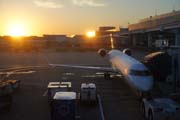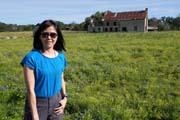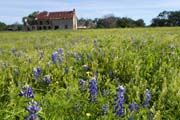Covering 268,596 square miles (695,660 km^2), and with over 30 million residents
as of 2023, it is the second-largest U.S. state by both area (after Alaska) and
population (after California). Texas is nicknamed the Lone Star
State for its former status as an independent republic. Spain was the first
European country to claim and control the area of Texas. Following a short-lived
colony controlled by France, Mexico controlled the territory until 1836 when
Texas won its independence, becoming the Republic of Texas. In 1845, Texas
joined the United States as the 28th state.
Getting there ...
 We
originally planned the trip to Dallas for the solar eclipse event on 4/8/2024.
However, the weather forecast in Dallas areas was not very promising on the day of the solar eclipse, so I started to think about a backup
plan. It seems the storm was moving from the west (in fact, all the way from
California) so it should have a better chance if we went toward the east of
Texas, and Hot Springs in Arkansas became a good alternative candidate (~ 5
hours from Dallas). I was able to book a room in the Hotel Hale in the
heart of the Hot Springs National Park just the day before our trip.
We
originally planned the trip to Dallas for the solar eclipse event on 4/8/2024.
However, the weather forecast in Dallas areas was not very promising on the day of the solar eclipse, so I started to think about a backup
plan. It seems the storm was moving from the west (in fact, all the way from
California) so it should have a better chance if we went toward the east of
Texas, and Hot Springs in Arkansas became a good alternative candidate (~ 5
hours from Dallas). I was able to book a room in the Hotel Hale in the
heart of the Hot Springs National Park just the day before our trip.
We had a red-eye flight on 4/5 late evening from SFO to Houston, and then a
short flight to Dallas. When we landed in Houston and waited for our
transfer flight, I got a message from our accommodation in Dallas saying that
our reservation was cancelled. In fact, I have been worry about this place for a
while: a few months ago I was notified that there was a ownership change
for this place. When I checked the Google review a few weeks ago, there
were full of 1 or 2-star reviews recently. Then I sent them messages
asking some questions a few days ago, but I had not got any reply back yet.
It turned out my backup plan became my rescue and we went to
Hot Springs National Park for
4/6 -- 4/9.
4/9 ...
We drove back to Texas from Hot
Springs in the early morning to continue (or resume) our planned Texas trip
(Austin, San Antonio, and Fort Worth). It was a hard raining day from the
morning in Hot Springs in Arkansas, all the way to Dallas/Waco in Texas at about
noon. It finally cleared up when we got to Austin at about 4PM.
4/10 ...
- Texas State Capitol
The current Texas State Capitol is the third
building to serve that purpose. Located in downtown Austin, Texas, the
structure houses the offices and chambers of the Texas Legislature and of
the Governor of Texas. Designed in 1881 and constructed from 1882 to 1888,
the Texas State Capitol was added to the National Register of Historic
Places in 1970 and recognized as a National Historic Landmark in 1986.
- Lady Bird Johnson Wildflower
Center
The Lady Bird Johnson Wildflower Center at The University of
Texas at Austin is 284 acres and located 10 miles southwest of downtown
Austin. It is the state botanical garden and arboretum of Texas. The
center features more than 900 species of native Texas plants in both garden
and natural settings and is home to a breadth of educational programs and
events. Spring is wildflower season in Central Texas.
Although many flowers blooming throughout the natural areas and garden at
the center, we found caterpillars everywhere and spent more time to look for
them than flowers.
- Google, Austin
We went back to Austin Downtown at ~ 11AM to meet
Woanyu's friend and had a free lunch at Google Austin.
- LBJ Ranch
The LBJ Ranch was where the President Lyndon B. Johnson was
born, lived, died, and was buried. After the president's death
in 1973, Mrs. Johnson continued to live at the Ranch part time until her
death in 2007. Visitors are now able to tour the Ranch at their own
pace in the self-guided driving tour to stop at sites along the way such as
the president's birthplace, Johnson family cemetery, and the president's
first school (but the Texas White House Complex including the hangar was
closed for rehabilitation).
- Bats in Austin
A 1980 renovation transformed the Congress Avenue
Bridge into an ideal bat cave, soon attracting migrating Mexican free-tailed
bats. Decades later, Austin's bat numbers have swelled and bat viewing at
sunset has become one of the most popular attractions in Austin.
Starting in late March and continuing through early fall, North America's
largest urban bat population calls Austin home. The bats begin to wake up
and start their night flight around sunset. We walked from our Airbnb
toward Austin Downtown and
sit at a dock of the Austin Rowing Club to wait for this amazing show.
4/11 ...
We drove to San Antonio in the early morning to have a day tour of this
southern Texas city.
- The Alamo, San Antonio
Established in 1718 as Mission San Antonio de Valero, the former mission now
known as the Alamo has been a crossroads of history. It was the site
of the Battle of the Alamo in 1836, a pivotal event of the Texas Revolution.
Today it is a museum in the Alamo Plaza Historic District and a part of the
San Antonio Missions World Heritage Site
- River Walk, San Antonio
The River Walk winds and loops under bridges
as two parallel sidewalks lined with restaurants and shops, connecting the
major tourist draws in San Antonio. Many agree that the best way
to see San Antonio is by taking a stroll along the River Walk. We also
took the boat tour, GO RIO,
which allows you to float through the river slowly and see the River Walk
from a different vantage point.
After the lunch at Schilo's (German-Texan), the oldest
restaurant in San Antonio, we headed south to start our tours to San Antonio
Missions. San Antonio Missions Historical Park is a National Historical
Park and part of a UNESCO World Heritage Site preserving four of the five
Spanish frontier missions in San Antonio. From north to south, the
missions are: Mission Concepción, Mission San Jose, Mission San Juan, and
Mission Espada. The fifth (and best known) mission in San Antonio,
the Alamo, is not part of the Park.
- Mission Concepción
Franciscan Friars established Mission Nuestra
Señora de la Purísima Concepción de Acuña (also Mission Concepción) in 1711
in East Texas. The mission was moved to San Antonio in 1731. Mission
Concepción is one of the oldest unrestored stone churches in America.
Catholic Mass is still held at the mission every Sunday.
- Mission San José
Misión San José y San Miguel de Aguayo was
established in 1720 because Mission San Antonio de Valero (aka the Alamo)
had become overcrowded. The church, which is still standing, was
constructed in 1768. Mission San José is the most complete and
reconstructed mission. You can experience the daily life of mission
residents, and explore quarters where Indigenous and Spanish mission
residents lived.
- Mission San Juan
Misión San Juan Capistrano was established in 1716
as Misión San Jose de los Nazonis in East Texas. The mission was renamed and
moved in 1731 to San Antonio. Mission San Juan did not prosper
to the same extent as the other San Antonio missions because lands allotted
to it were not sufficient to plant vast quantities of crops, or breed large
numbers of horses and cattle.
- Mission Espada
Founded in 1690 as San Francisco de los Tejas near
Weches, Texas and southwest of present-day Alto, Texas, Mission San
Francisco de la Espada was the second mission established in Texas.
The mission was moved in 1731 to San Antonio and given its current name.
The original acequia (irrigation) still flows through the community.
This continuity of history is one reason the missions of San Antonio are
recognized as a World Heritage Site.
- We went back to the River Walk after visiting the missions to have a
nice and relax dinner by the river. It felt more like a small European town
than a big American city.
4/12 ...
- Marble Falls
We made a detour to the Bluebonnet House in Marble Falls
when we drove north toward Fort Worth. But when we got there, I was
quite disappointed with the conditions of wildflowers. I was not sure
if we missed the peak blooming season or it was not a good year.
 |
 |
|
|
- Waco Mammoth
The Waco Mammoth National Monument is a paleontological
site and museum where fossils of 24 Columbian mammoths (Mammuthus columbi)
and other mammals from the Pleistocene Epoch have been uncovered.
Standing as tall as 14 feet and weighing 20,000 pounds, Columbian mammoths
roamed across what is present-day Texas thousands of years ago. Today, the
fossil specimens represent the nation's first and only recorded evidence of
a nursery herd of ice age Columbian mammoths. The site was discovered
in 1978 by late teens Paul Barron and Eddie Bufkin, who were searching for
arrowheads and fossils on a farm near the Bosque River. They found a large
bone and, thinking it was a cow bone. After pulling it completely out of the
ground, they discovered that the bone was 3 feet long, much too big to be a
cow bone. They then took it to the Strecker Museum at Baylor University for
analysis. Once the bone was identified as Columbian mammoth, the
museum staff organized a formal dig at the site lasting from 1978 to 1990.
- iFLY, Fort Worth
iFLY is an
indoor skydiving experience. iFLY’s state-of-the-art wind tunnels are
designed to provide a safe flight experience and unique memories.
With a group of 8 people, it took about an hour for check-in, suit-up,
orientation (including watching a video), 2 flights for each person (60
seconds/flight), and final debrief. Here are the videos for our
flights (Yenwen,
Woanyu)
4/13 ...
[Back to Photo Page]
We
originally planned the trip to Dallas for the solar eclipse event on 4/8/2024.
However, the weather forecast in Dallas areas was not very promising on the day of the solar eclipse, so I started to think about a backup
plan. It seems the storm was moving from the west (in fact, all the way from
California) so it should have a better chance if we went toward the east of
Texas, and Hot Springs in Arkansas became a good alternative candidate (~ 5
hours from Dallas). I was able to book a room in the Hotel Hale in the
heart of the Hot Springs National Park just the day before our trip.